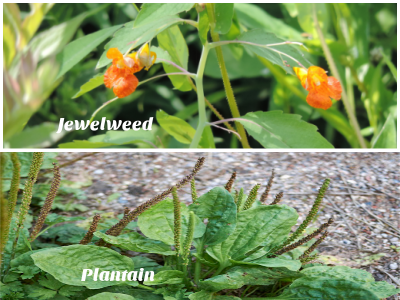“Leaves of Three, Let it be”
“Longer Middle Stem, Don’t Touch Them”
“Hairy Vine, No Friend of Mine”
Let’s take a closer look at the suspected “Leaves of Three.” When you’re looking at Poison ivy, you’ll see a distinctive longer stem at the base of the middle leaflet. As a result, the middle leaflet extends farther out from the leaflet stem than the two side leaflets.
“Hairy Vine, No Friend of Mine” You’re most likely to encounter poison ivy on tree trunks, rock walls where it can climb up as a vine. Poison ivy vines feature numerous distinctive small tendrils, or “hairs,” that the plant uses to adhere to whatever it is climbing.
The Facts: There are a few look-alike plants that gardeners could mistake for poison ivy. Boston ivy-each leaflet is attached by a stalk. In poison ivy, generally only the top leaflet is attached by a stalk. Mature Boston ivy leaves are three-lobed, but not separated into separate leaflets. People also often confuse Virginia creeper with poison ivy, but Virginia creeper has five leaves, not three. Virginia creeper’s sap can also cause an annoying rash.
Poison Ivy has shiny green leaves that grow in groups of three. Poison ivy may grow as a vine or as a low shrub.
Poison Oak also has leaves grouped in three. It grows as a low shrub, which may have clusters of green or white berries.
Poison Sumac has around 7-13 leaves found in pairs with a single leaf at the end. These long, smooth leaves are a pretty, bright orange and velvet like in the spring. They become dark green and glossy on top and light green underneath. Sumac grows as a tree in swampy areas.
Let’s talk about the culprit associated with Poison Ivy, Urushiol! (u-ROO-she-ol) The compounds with allergenic properties found in plants of the family of Anacardiaceae. (Anna-card_A- Cee-I) The Anacardiaceae family of trees, includes mango (where the Urushiol is found in the leaves, bark and skin), poison ivy, poison oak, sumac, Peruvian pepper, pistachio, and, cashews. (Urushiol is the reason cashews are never sold in the shell and are typically roasted. The oil is found on the outer shell and roasting the cashews at high temperatures can kill any remaining oil that makes its way through to the nut.
I digress! Back to Urishiol and Poison Ivy! The vines and leaves of poison ivy contain heavy amounts of Urushiol, which, when touched by the skin, causes the allergic reaction (contact dermatitis) to affected skin. Urushiol is found in the sap of the Poison Ivy plant! (Did you know many animals can eat the leaves or interact with the plant without trouble?) Urushiol oil binds to the skin in 20 minutes or less, and it’s concentrated stuff! You do not have to be exposed much: 50 micrograms of urushiol — an amount SMALLER than a grain of salt — is enough to cause a reaction! Urushiol oil is durable! Even when the plant is dormant, it still holds Urishiol oil! The plant won’t produce more of it after it dies, but the oil can linger for YEARS! You’ll definitely need a trip to the emergency room if you unknowingly burn it in a pile of dead wood, inhaling the smoke, which can carry urushiol oil into your lungs. This nasty toxin can also become airborne from wildfires and lawnmowers.
There may be hope! Folklore tells us that poison ivy always grows near jewelweed and plantain, which cures it! What an enduring example of the wholeness of nature!

Jewelweed (Impatiens capensis) is also known as spotted touch-me-not or orange touch me not. It is an annual plant that self seeds, so once you know where it grows, you can easily find it in the same spot year after year.
Fun Fact: Jewelweed was named this way because if you put it under water in a flowing stream, it looks like a beautiful jewel!
Plantain known as Plantago major and by some, The Medicine Plant or Band-aid plant, for good reason! It hosts powerful healing benefits! (We LOVE using the versatile, Plantain here at BrierBee) Fun Fact! Have a splinter? Simply crush or chew your plantain leaf, place it over the area with the sliver, bandage and leave overnight. In the morning, the sliver should easily pop out.
Jewelweed and Plantain work well together to help reduce swelling, itching and promote healing! (Now, folklore also tells us that there has not been a scientific study that proves that jewelweed or plantain is a cure, though it is commonly said to be used for centuries in different cultures.)
Want to have an herbal preparation ready?.. Crush up your jewelweed and plantain. I crush the jewelweed with my mortar and pestle. I don’t crush it too much, but enough that it will expose more of the surface…(continue reading, for why!) Pay attention to the thicker areas where the leaves attach to the stem–these are the most juice filled.
Chop up jewelweed finely into a Mason jar.. a good pair of kitchen scissors will help this. You don’t want to over-fill the jar but do fill it up loose.
Add witch hazel. Now, pour in your witch hazel, ensuring that it covers the Jewelweed & Plantain fully. If the jewelweed & plantain are too firmly packed, you’ll end up with less (after you remove the plant material in a few weeks). Allow to sit (macerate) in a cool, dark place 2-3 weeks (shaking the jar to mix once or twice a day) Strain out the plant material (you can do this by gloved hands and a cheesecloth). Place the liquid back in the jar, ensuring that you don’t have any extra plant material.
Using your Jewelweed & Plantain Infused Witch Hazel–Use a cotton ball and liberally apply the preparation to the area in a pinch!
*For severe reactions to Urushiol, seek immediate medical attention*





Add Comment